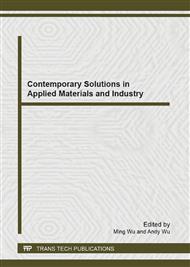[1]
T. Thiringer, A. Petersson, and T. Petru, Grid disturbance response of wind turbines equippedwith induction generator and doubly-fed induction generator, in Proc. IEEE PES Annu. Meeting, Jul. 2003, p.13–16.
DOI: 10.1109/pes.2003.1267384
Google Scholar
[2]
A. Feij´oo, J. Cidr´as, and C. Carrillo, A third order model for the doubly fed induction machine, Elect. Power Syst. Res., vol. 56, p.121–127, Nov. (2000).
Google Scholar
[3]
M. A. P¨oller, Doubly-fed induction machine models for stability assessment of wind farms, in Proc. IEEE Bologna Power Tech., Bologna, Italy, Jun. 23–26, (2003).
DOI: 10.1109/ptc.2003.1304462
Google Scholar
[4]
J. B. Ekanayake, L. Holdsworth, andN. Jenkins, Comparison of 5th order and 3rd order machine models for doubly fed induction generator (DFIG) wind turbines, Elect. Power Syst. Res., vol. 67, p.207–215, Dec. (2003).
DOI: 10.1016/s0378-7796(03)00109-3
Google Scholar
[5]
P. Ledesma and J. Usaola, Effect of neglecting stator transients in doubly fed induction generatormodels, IEEE Trans. Energy Conv., vol. 19, no. 2, p.459–461, Jun. (2004).
DOI: 10.1109/tec.2004.827045
Google Scholar
[6]
Ling Peng, Yongdong Li, Bruno Francois, Modeling and Control of Doubly Fed Induction Generator Wind Turbines by Using Causal Ordering Graph during Voltage Dips, ICEMS 2008, China, CD-ROM.
DOI: 10.1109/ipemc.2009.5157460
Google Scholar
[7]
J.K. Niiranen, Simulation of Doubly Fed Induction Generator wind turbine with an active crowbar, EPE-PEMC 2004, Latvia, CD-ROM.
Google Scholar
[8]
J. Morren, S. W. H. de Haan, Ridethrough of wind turbines with doubly-fed induction generator during a voltage dip,. IEEE Trans. Energy Conversion, vol. 20, no. 2, p.435–441, Jun. (2005).
DOI: 10.1109/tec.2005.845526
Google Scholar
[9]
A. Bouscayrol, B. Davat, B. de Fornel, B. Francois, JP. Hautier, F. Meibody-Tabar, et al, Multi-machine multi-converter system: application for the electromechanical conversion, EPJ Appl Phys 2000; 10(2): 131–47.
DOI: 10.1051/epjap:2000124
Google Scholar
[10]
B. Francois, Ph. Delarue, A. Bouscayrol, J. Niiranen, Five-leg ac–ac power converter: structure, modeling and control, IEEE–IAS annual meeting 2000, Rome, October 2000, CD-ROM.
DOI: 10.1109/ias.2000.882085
Google Scholar


